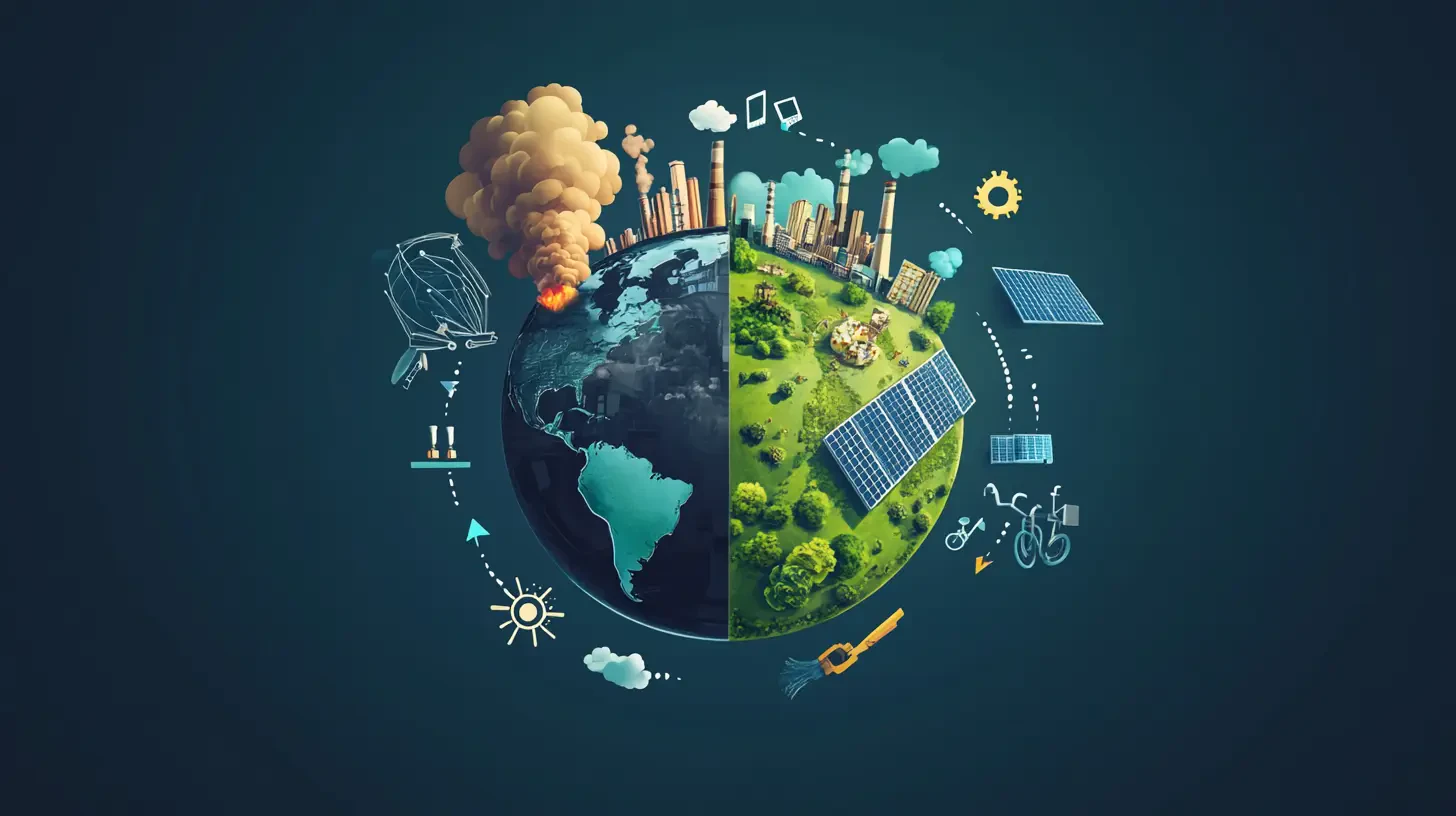What is a Carbon Footprint? Understanding Its Meaning, Components, and Environmental Impact

Carbon Footprint, or the carbon footprint, refers to the total amount of greenhouse gases emitted from human activities or processes, measured in terms of carbon dioxide equivalent. It is a key indicator for assessing environmental impact and global warming, while also helping to plan for the reduction of greenhouse gas emissions to achieve sustainability in the future.
What is a Carbon Footprint?
Carbon Footprint, or carbon footprint, refers to the total amount of greenhouse gases emitted from various activities or processes. It primarily consists of carbon dioxide (CO₂) and other greenhouse gases such as methane, nitrous oxide, hydrofluorocarbons (HFCs), perfluorocarbons (PFCs), sulfur hexafluoride (SF₆), and nitrogen trifluoride (NF₃), among others. Measuring the carbon footprint allows us to assess the environmental impact of different activities and their contribution to global warming.Activities that contribute to the carbon footprint include:
- Energy consumption: Electricity use in homes and buildings, heating, and lighting.
- Transportation: Personal vehicle use, freight transport, and air travel.
- Manufacturing processes: From sourcing raw materials and production to product disposal.
- Agriculture and livestock: Crop cultivation and animal farming release methane and nitrous oxide.
- Waste management: Waste disposal and wastewater treatment.
The Importance of Carbon Footprint
Carbon Footprint is highly significant as it serves as a key indicator of the impact humans have on the environment and climate change. The effects of Carbon Footprint can be categorized into two main levels.Global Impact
- Climate Change: The large-scale emission of greenhouse gases is the primary cause of global warming, leading to a rise in the Earth's average temperature at an unprecedented rate.
- Polar Ice and Glacier Melting: This results in rising sea levels, posing a threat to coastal areas and small islands.
- Loss of Biodiversity: Rapid environmental changes prevent many species from adapting, leading to extinction.
- Weather Volatility: More frequent extreme weather events such as storms, floods, and droughts directly affect people’s lives and properties.
- Health Impacts: The increasing number of natural disasters leads to health issues, including injuries, infectious diseases, and mental health problems.
- Economic Damage: Disasters cause destruction to property, agricultural land, and infrastructure, leading to income loss and economic slowdowns.
- Resource Scarcity: Climate change can contribute to water and food shortages in certain areas, affecting food and water security.
Types and Scope of Carbon Footprint
Carbon Footprint can be divided into two main categories: Organization Carbon Footprint and Product Carbon Footprint.Organization Carbon Footprint refers to the amount of greenhouse gases emitted from all activities of an organization. These emissions are categorized into three scopes according to the GHG Protocol standard:
-
Scope 1: Direct Emissions
These are emissions that result from activities directly under the control of the organization.
Examples include fuel combustion in machinery, boilers, company-owned vehicles, and refrigerant leaks. -
Scope 2: Energy Indirect Emissions
These are indirect emissions from the consumption of purchased or acquired energy.
Examples include electricity, heat, or steam purchased from external suppliers. -
Scope 3: Other Indirect Emissions
These emissions are associated with the organization but are not directly controlled by it.
Examples include employee travel, raw material transportation, waste disposal, and the use of the organization's products by consumers.
Calculating both types of Carbon Footprints helps organizations identify key sources of greenhouse gas emissions and develop effective strategies for emission reduction. Reports typically express emissions in kilograms or tons of carbon dioxide equivalent (kgCO 2e or tCO2e).
Understanding the types and scopes of Carbon Footprints is essential for developing comprehensive and effective greenhouse gas reduction strategies at both organizational and product levels.
The Impact of Carbon Footprint on the Planet and Society
Carbon Footprint has a significant impact on both the environment and society, which can be categorized into two main aspects.Environmental Impacts
- Global Warming: The increase in greenhouse gases in the atmosphere raises the Earth's average temperature. If no action is taken, global temperatures could rise by up to 3°C in the future.
- Loss of Biodiversity: Rapid climate change makes it difficult for many species to adapt. Studies indicate that global wildlife populations have declined by 69% since 1970.
- Melting Glaciers and Polar Ice: Global warming accelerates ice melting, leading to rising sea levels, which could increase by approximately 1 ± 0.5 meters over the next 100 years.
- Ecosystem Changes: Climate change disrupts both terrestrial and marine ecosystems, affecting seasonal patterns, animal migration, and natural food sources.
- Health Issues from Pollution: The rise in greenhouse gases and air pollution contributes to respiratory diseases, heart disease, and certain types of cancer.
- Food Security Challenges: Extreme and unpredictable weather conditions affect agriculture, fisheries, and livestock, leading to food shortages and malnutrition in some areas.
- Climate-Induced Migration: Severe natural disasters such as floods, droughts, and storms force people to relocate, causing social and economic challenges.
- Economic Consequences: Climate change damages infrastructure, property, and economic activities. Thailand is ranked among the ten countries most at risk from long-term climate change.
- Social Inequality: The effects of Carbon Footprint disproportionately impact low-income groups and developing countries, as they have fewer resources to adapt and respond.
Assessment and Measurement of Carbon Footprint
The evaluation and measurement of the carbon footprint involve the following key steps and tools.1. Tools and Standards
- GHG Protocol: A globally recognized standard that provides a framework for calculating and reporting greenhouse gas (GHG) emissions.
- ISO 14064: An international standard for GHG reporting and verification, consisting of three key components: defining boundaries, identifying data sources, and performing calculations.
- Define Scope and Objectives: Identify the activities to be assessed and the time period for data collection.
- Data Collection: Gather data on energy consumption, raw materials, and other resources.
- Select Emission Factor: Use an appropriate emission factor to quantify GHG emissions.
- GHG Emission Calculation: Apply the formula:
GHG Emission = Activity Data × Emission Factor - Analysis and Interpretation: Identify major emission sources and opportunities for reduction.
- Reporting: Prepare reports following the required standards.
-
For Organizations
- Scope 1: Emissions from fuel consumption in production processes and company-owned vehicles.
- Scope 2: Emissions from purchased electricity.
- Scope 3: Emissions from employee travel, raw material transportation, and waste disposal.
-
For Individuals
- Travel: Calculated based on distance traveled and type of vehicle used.
- Electricity Use: Based on household electricity consumption.
- Food Consumption: Based on the type and quantity of food consumed.
- Expressed in kilograms of CO2 equivalent (kgCO2e) or tons of CO2 equivalent (tCO2e).
- Presented using graphs or charts for clarity.
- Compared against organizational or national GHG reduction targets.
Sustainable Ways to Reduce Carbon Footprint
Reducing Carbon Footprint is essential for mitigating the impacts of climate change. The following are key approaches and strategies:1. Reducing Energy Use and Increasing Efficiency
- Improve the efficiency of equipment and systems, such as installing thermal insulation on walls and roofs or using heat-reflective roofing to regulate indoor temperatures.
- Install smart control systems and sensors, such as automated lighting management and smart meters.
- Choose energy-efficient appliances, such as LED light bulbs, energy-efficient electrical appliances, and induction cookers.
- Use energy-saving ballasts or electronic ballasts with compact fluorescent lamps.
- Utilize lighting fixtures with reflective panels to maximize light efficiency.
- Install solar power systems (Solar Rooftop) on buildings and factories.
- Use biomass energy, such as producing biogas from animal waste and wastewater treatment systems.
- Consider wind and hydro energy in areas with suitable potential.
- Increase the proportion of locally sourced and seasonal food to reduce long-distance transportation.
- Minimize food waste by planning purchases and consumption carefully.
- Use recycled products and reduce single-use plastic consumption.
- Choose durable and repairable products to extend their lifespan.
- Plant trees to expand green spaces and absorb carbon dioxide; a large tree can absorb approximately 22 kg of CO2 per year.
- Conserve and restore natural forests, which serve as crucial carbon sinks.
- Promote urban forestry to enhance green spaces in cities.
- Encourage the use of public transportation and clean-energy vehicles.
- Use electric or hybrid vehicles to reduce greenhouse gas emissions from transportation.
- Plan travel and logistics efficiently to minimize distance and fuel consumption.
- Promote waste separation and recycling to reduce the amount of waste that needs disposal.
- Implement efficient waste management technologies, such as waste-to-energy systems.
- Reduce unnecessary packaging and opt for environmentally friendly materials.
Summary and Future of Carbon Footprint
Reducing Carbon Footprint is a global challenge that requires collaboration from all sectors—individuals, organizations, and nations—to build a sustainable future.1. The Importance of Participation
Addressing the Carbon Footprint issue cannot be done by any single group alone; it requires cooperation across all sectors. Governments must implement policies and measures that support the reduction of greenhouse gas emissions. The private sector must adapt its production processes and business operations to be more environmentally friendly. Meanwhile, individuals must adjust their consumption habits and daily lifestyles.
2. Technology and Innovation
The development of green technology and smart infrastructure plays a crucial role in effectively reducing Carbon Footprint. This includes the use of renewable energy, the advancement of smart transportation systems, and the application of IoT technology for energy and resource management. For example, the One Bangkok project utilizes a centralized cooling system, saving 17,000 megawatt-hours of electricity per year and reducing carbon emissions by 9,000 tons annually.
3. Raising Public Awareness
Instilling awareness about Carbon Footprint and its environmental impact is essential. This effort should begin within the education system, workplaces, and communities to foster a culture of Carbon Footprint reduction. Encouraging public participation in carbon-offsetting activities, such as walking or cycling instead of using cars for short trips, not only helps reduce carbon dioxide emissions but also promotes better health and quality of life.
4. Integrating Policies and Market Mechanisms
A combination of government policies and market mechanisms is vital in motivating all sectors to participate in reducing greenhouse gas emissions. This includes the development of carbon credit systems and carbon trading. Moreover, fostering cooperation between the government, private sector, and local authorities will facilitate knowledge exchange and lead to the development of effective Carbon Footprint reduction strategies that truly meet societal needs.
Achieving a sustainable future requires long-term commitment and collaboration from all sectors, starting today, to create a livable world for future generations. Reducing Carbon Footprint not only helps mitigate the impacts of climate change but also contributes to sustainable improvements in quality of life, economic growth, and social well-being.
About Optiwise
Optiwise offers Investor Relations & ESG consulting services, corporate website design, and IR website development. We also provide advisory services for initial public offerings (IPOs) and assists in preparing disclosure documents for public companies. Additionally, our public relations efforts aim to build credibility and enhance the corporate image.
For more information about Optiwise's services, please contact us here.


